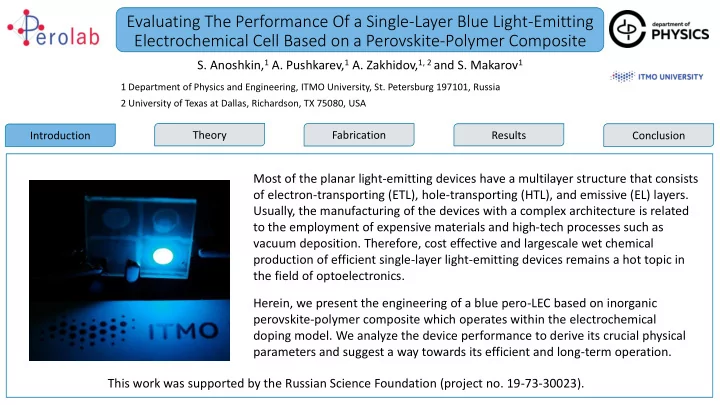

Evaluating The Performance Of a Single-Layer Blue Light-Emitting Electrochemical Cell Based on a Perovskite-Polymer Composite S. Anoshkin, 1 A. Pushkarev, 1 A. Zakhidov, 1, 2 and S. Makarov 1 1 Department of Physics and Engineering, ITMO University, St. Petersburg 197101, Russia 2 University of Texas at Dallas, Richardson, TX 75080, USA Introduction Theory Fabrication Results Conclusion Most of the planar light-emitting devices have a multilayer structure that consists of electron-transporting (ETL), hole-transporting (HTL), and emissive (EL) layers. Usually, the manufacturing of the devices with a complex architecture is related to the employment of expensive materials and high-tech processes such as vacuum deposition. Therefore, cost effective and largescale wet chemical production of efficient single-layer light-emitting devices remains a hot topic in the field of optoelectronics. Herein, we present the engineering of a blue pero-LEC based on inorganic perovskite-polymer composite which operates within the electrochemical doping model. We analyze the device performance to derive its crucial physical parameters and suggest a way towards its efficient and long-term operation. This work was supported by the Russian Science Foundation (project no. 19-73-30023).
Evaluating The Performance Of a Single-Layer Blue Light-Emitting Electrochemical Cell Based on a Perovskite-Polymer Composite S. Anoshkin, 1 A. Pushkarev, 1 A. Zakhidov, 1, 2 and S. Makarov 1 Introduction Theory Fabrication Results Conclusion Lead halide perovskites • Room-temperature excitonic emission with high quantum yield • Spectral linewidth of 14-30 nm References • Efficient light output and high color purity [1] Chem. Soc. Rev., 2018, 47 . p. 7045 • [2] Nano Lett., 2015, 15 , pp 3692 Cost-effective and largescale wet chemical production [3] PNAS , 2016, 113 , 11694
Evaluating The Performance Of a Single-Layer Blue Light-Emitting Electrochemical Cell Based on a Perovskite-Polymer Composite S. Anoshkin, 1 A. Pushkarev, 1 A. Zakhidov, 1, 2 and S. Makarov 1 Introduction Conclusion Theory Fabrication Results Pero-LEC fabrication process Perovskite-polymer ink spin-casting CsPbCl 1.12 Br 1.88 Cs 4 PbCl 3.04 Br 2.96 (8:1)-PEO Vacuum drying Annealing ITO 1 μ m 500 nm glass Cross-section (left) and top-view (right) SEM images of CsPbCl 1.12 Br 1.88 Cs 4 PbCl 3.04 Br 2.96 (8:1)-PEO film on ITO substrate Schematically represented Fabricated pero-LEC pero-LEC structure
Evaluating The Performance Of a Single-Layer Blue Light-Emitting Electrochemical Cell Based on a Perovskite-Polymer Composite S. Anoshkin, 1 A. Pushkarev, 1 A. Zakhidov, 1, 2 and S. Makarov 1 Introduction Results Conclusion Theory Fabrication Fabricated pero-LECs Characteristics 1000 10000 100 1000 2 ) Current density (mA/cm Brightness (cd/m 10 100 1 10 2 ) 0.1 1 0.01 0.1 0 1 2 3 4 Voltage (V) EL spectra of the fabricated pero-LEC J – V and L – V characteristics of the fabricated pero-LEC • λ EL = 478 nm, FWHM = 14 nm, L = 217 cd/m 2 (under 3.2 V forward bias) Fabricated pero-LEC • V ON = 2.6 V
Evaluating The Performance Of a Single-Layer Blue Light-Emitting Electrochemical Cell Based on a Perovskite-Polymer Composite S. Anoshkin, 1 A. Pushkarev, 1 A. Zakhidov, 1, 2 and S. Makarov 1 Introduction Results Conclusion Theory Fabrication J – V and L – V characteristics of the Ohmic region of Current-Voltage Characteristic fabricated pero-LEC 1000 10000 𝑘 ∝ 𝑊 100 1000 2 ) Current density (mA/cm Brightness (cd/m 10 100 1 10 2 ) 0.1 1 0.01 0.1 0 1 2 3 4 Voltage (V)
Evaluating The Performance Of a Single-Layer Blue Light-Emitting Electrochemical Cell Based on a Perovskite-Polymer Composite S. Anoshkin, 1 A. Pushkarev, 1 A. Zakhidov, 1, 2 and S. Makarov 1 Introduction Results Conclusion Theory Fabrication J – V and L – V characteristics of the Shockley region of Current-Voltage Characteristic fabricated pero-LEC 𝑟𝑊 𝑘 𝑊 = 𝑘 0 exp − 1 𝜃𝑙𝑈 1000 10000 100 1000 2 ) Current density (mA/cm Brightness (cd/m 10 100 1 10 2 ) 0.1 1 0.01 0.1 0 1 2 3 4 Voltage (V) Fitting parameters: 𝑙𝑈 = 0,025 eV 𝑘 0 = 1.83*10 -4 mA/cm 2 𝜃 = 9.77
Evaluating The Performance Of a Single-Layer Blue Light-Emitting Electrochemical Cell Based on a Perovskite-Polymer Composite S. Anoshkin, 1 A. Pushkarev, 1 A. Zakhidov, 1, 2 and S. Makarov 1 Introduction Conclusion Theory Fabrication Results J – V and L – V characteristics of the Saturation region of Current-Voltage Characteristic fabricated pero-LEC 𝑐𝑗 2 𝑘 = 9 8 𝜁 𝑠 𝜁 0 𝜈 𝑊 − 𝑊 𝑒 3 1000 10000 100 1000 2 ) Current density (mA/cm Brightness (cd/m 10 100 1 10 2 ) 0.1 1 0.01 0.1 Fitting parameters: 0 1 2 3 4 𝜁 𝑠 = 20 (literature) Voltage (V) 𝑊 𝑐𝑗 = 2.36 eV d = 300 nm 𝜈 = 1.4 m 2 /V*s
Evaluating The Performance Of a Single-Layer Blue Light-Emitting Electrochemical Cell Based on a Perovskite-Polymer Composite S. Anoshkin, 1 A. Pushkarev, 1 A. Zakhidov, 1, 2 and S. Makarov 1 1 Department of Physics and Engineering, ITMO University, St. Petersburg 197101, Russia 2 University of Texas at Dallas, Richardson, TX 75080, USA Introduction Theory Fabrication Results Conclusion 1. A new approach to simple fabrication of single-layer blue pero-LECs based on perovskite-polymer thin film is developed. The device demonstrates low turn-on voltage of 2.6 V and relatively bright (217 cd/m 2 ) narrowband electroluminescence at 478 nm under 3.2 V forward bias. 2. Numerous structural defects generated during its operation dramatically affects electron-hole radiative recombination, in particular, a very large ideality factor (h=9.77) of the Shockley-Read-Hall behavior and relatively low charge carrier mobility m = 1.4 cm 2 /Vs are established. In this context, single-layer pero-LECs operating within electrochemical doping (ECD) model do not seem prospective devices for the development of the next-generation display technology. 3. Substantial improvement of pero-LECs electroluminescence, however, could be proposed for the devices operating within the electrodynamic (ED) model. The latter requires adding of salts producing high-mobility ions for rapid formation of a p-i-n junction and hence providing the intrinsic perovskite layer with a free field region. sergey.anoshkin@metalab.ifmo.ru
Recommend
More recommend